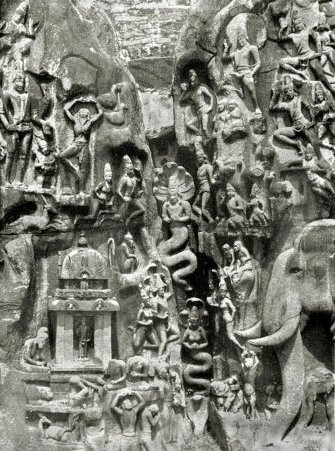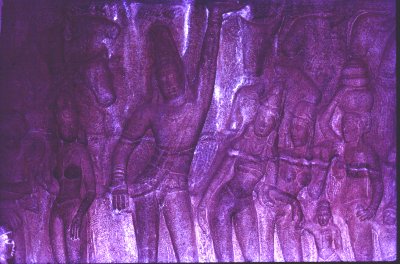Pallava Art and Architecture
by Jyotsna Kamat
First
Online: June 12, 2005
Page Last Updated: December 07, 2024
The long period of the Pallava rule represents both rock-cut architecture and early constructed stone temples. The brick, timber, metal and mortar part could hardly survive in the warm and humid climate of the region. But the lasting monolithic temples known as rathas and mandapas provide superb skill of sculptors of Pallava period.
Narasimhavarman I, was a s great a patron of art and architecture as he was the commander of the army. He called himself "Mamalla" (Kannada mahamalla -great wrestler) and named the town where he built temples as Mamallapuram, now known as Mahabalipuram. It must have bee a big sea port at the mouth of the Palar River, thirty two miles south of Chennai. The large granite hill 100 ft high and half a mile in length from north to south and quarter a mile wide, with smaller protrusions provided unique scope for the Pallava sculptors. Prof. K.A. Nilakanta Sastri writes that Mamallapuram was one of the chief entry port of South India and from it streamed forth strong cultural influences which shaped the art of Hindu colonies of Indonesia and Cambodia.
There are clear traces of carefully designed system of water supply from Palar River to the ancient city. The huge sculpture of "The Descent of the Ganges" also known as Arjuna's Penance was related to this system of water supply. The large cliff, thirty yards long and twenty three ft high, represents naga and naginis which symbolize water, adoring both sides of deities along with animals. For some it is a regular and vast fresco in stone. According to Grousset, "This relief is a master piece of classic art in the breadth of its composition, the sincerity of its impulse which draws all creatures together round the beneficent waters, and its deep, fresh love of nature"
V.N.O'key/Kamat's Potpourri
The Descent of Ganga River
Sculpture from Mahabalipuram in Tamilnadu
There is an emaciated figure of Bhagiratha practicing penance. Among the animals, right from elephants, to the ascetic cat with trustful mice at its feet deer and monkeys are depicted in artistic but natural poses.
The mandapas, pilasters and mouldings are all intricately carved with Mythological themes. Krishna raising Govardhana hill, Vishnu relaxing on a serpent -sofa, Durga with demon Mahisha, are all depicted.
V.N. O'key/Kamat's Potpourri
Temple Sculpture from Mahabalipuram
Pallava period art, Tamilnadu
The monolithic seven Pagodas or rathas named after Pandavas are architectural wonders, though sea-erosion has taken its toll. They are copies of Viharas and Chaityas. The vihara type or pyramidal shape is seen in Dharmaraja Ratha. Bhima, Sahadeva and Ganesha Rathas are of Chaitya type. Lion motif appeared in these shore temples of later period. Kailasanatha and Vaikuntha Perumal temples are typical of Pallava architecture. Mandapa, Vimana and Gopuram constructions appeared during this period. There are smaller temples near Chingleput, Arkonam and Renigunta all apsidal in character and modeled after Sahadeva Ratha at Mahabalipuram. Pallava style of architecture traveled beyond the seas.
Political conflict of Pallavas with Chalukyas, Cholas and Pandyas were no obstacle to cultural growth. There was revival of Vedantic or Hindu worship in all the regions of South India. Devotional and classical Sanskrit as also Tamil literature developed. There was mutual exchange of architectural styles between the Pallavas and Chalukyas. Temples in Pattadkal clearly show the influence of Pallava School. Architects of southern region also find mention in the contemporary Kannada inscriptions. Sculpture, painting and music found their way in colonies across the sea.
![]()
See Also:
- The Pallavas -- Article on the art and architecture of the prominent Pallava dynasty that rules South India from 4th to 9th centuries CE.

